Jezebel: Examining Biblical and Archaeological Accounts
VerifiedAdded on 2022/10/18
|7
|1681
|18
Essay
AI Summary
This essay delves into the character of Jezebel, a prominent figure in the Old Testament, aiming to construct a methodological historiography by critically examining both biblical and archaeological evidence. The essay explores the biblical portrayal of Jezebel as the wife of King Ahab, highlighting her controversial actions and their impact on the Kingdom of Israel, including her alleged promotion of Baal worship and persecution of prophets. The essay then transitions to the archaeological perspective, discussing the discovery of a seal bearing the name YZBL, which provides potential evidence of her existence, despite the lack of physical remains mentioned in the Bible. Through a comparative analysis of these sources, the essay seeks to determine the historical accuracy of Jezebel's portrayal and her significance in ancient history.

Running head: JEZEBEL
Name of the Student
Name of the University
Author Note
Name of the Student
Name of the University
Author Note
Paraphrase This Document
Need a fresh take? Get an instant paraphrase of this document with our AI Paraphraser
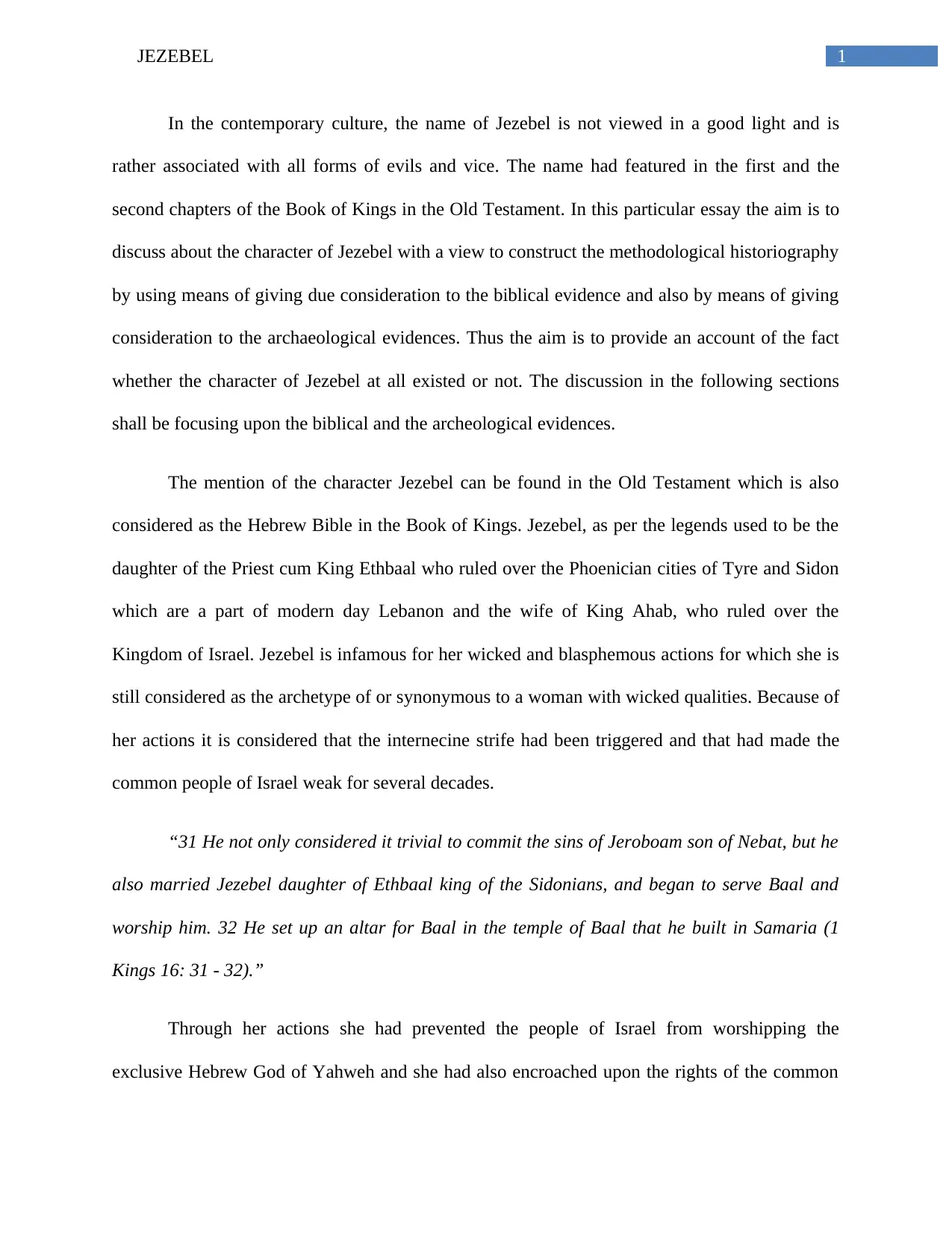
1JEZEBEL
In the contemporary culture, the name of Jezebel is not viewed in a good light and is
rather associated with all forms of evils and vice. The name had featured in the first and the
second chapters of the Book of Kings in the Old Testament. In this particular essay the aim is to
discuss about the character of Jezebel with a view to construct the methodological historiography
by using means of giving due consideration to the biblical evidence and also by means of giving
consideration to the archaeological evidences. Thus the aim is to provide an account of the fact
whether the character of Jezebel at all existed or not. The discussion in the following sections
shall be focusing upon the biblical and the archeological evidences.
The mention of the character Jezebel can be found in the Old Testament which is also
considered as the Hebrew Bible in the Book of Kings. Jezebel, as per the legends used to be the
daughter of the Priest cum King Ethbaal who ruled over the Phoenician cities of Tyre and Sidon
which are a part of modern day Lebanon and the wife of King Ahab, who ruled over the
Kingdom of Israel. Jezebel is infamous for her wicked and blasphemous actions for which she is
still considered as the archetype of or synonymous to a woman with wicked qualities. Because of
her actions it is considered that the internecine strife had been triggered and that had made the
common people of Israel weak for several decades.
“31 He not only considered it trivial to commit the sins of Jeroboam son of Nebat, but he
also married Jezebel daughter of Ethbaal king of the Sidonians, and began to serve Baal and
worship him. 32 He set up an altar for Baal in the temple of Baal that he built in Samaria (1
Kings 16: 31 - 32).”
Through her actions she had prevented the people of Israel from worshipping the
exclusive Hebrew God of Yahweh and she had also encroached upon the rights of the common
In the contemporary culture, the name of Jezebel is not viewed in a good light and is
rather associated with all forms of evils and vice. The name had featured in the first and the
second chapters of the Book of Kings in the Old Testament. In this particular essay the aim is to
discuss about the character of Jezebel with a view to construct the methodological historiography
by using means of giving due consideration to the biblical evidence and also by means of giving
consideration to the archaeological evidences. Thus the aim is to provide an account of the fact
whether the character of Jezebel at all existed or not. The discussion in the following sections
shall be focusing upon the biblical and the archeological evidences.
The mention of the character Jezebel can be found in the Old Testament which is also
considered as the Hebrew Bible in the Book of Kings. Jezebel, as per the legends used to be the
daughter of the Priest cum King Ethbaal who ruled over the Phoenician cities of Tyre and Sidon
which are a part of modern day Lebanon and the wife of King Ahab, who ruled over the
Kingdom of Israel. Jezebel is infamous for her wicked and blasphemous actions for which she is
still considered as the archetype of or synonymous to a woman with wicked qualities. Because of
her actions it is considered that the internecine strife had been triggered and that had made the
common people of Israel weak for several decades.
“31 He not only considered it trivial to commit the sins of Jeroboam son of Nebat, but he
also married Jezebel daughter of Ethbaal king of the Sidonians, and began to serve Baal and
worship him. 32 He set up an altar for Baal in the temple of Baal that he built in Samaria (1
Kings 16: 31 - 32).”
Through her actions she had prevented the people of Israel from worshipping the
exclusive Hebrew God of Yahweh and she had also encroached upon the rights of the common
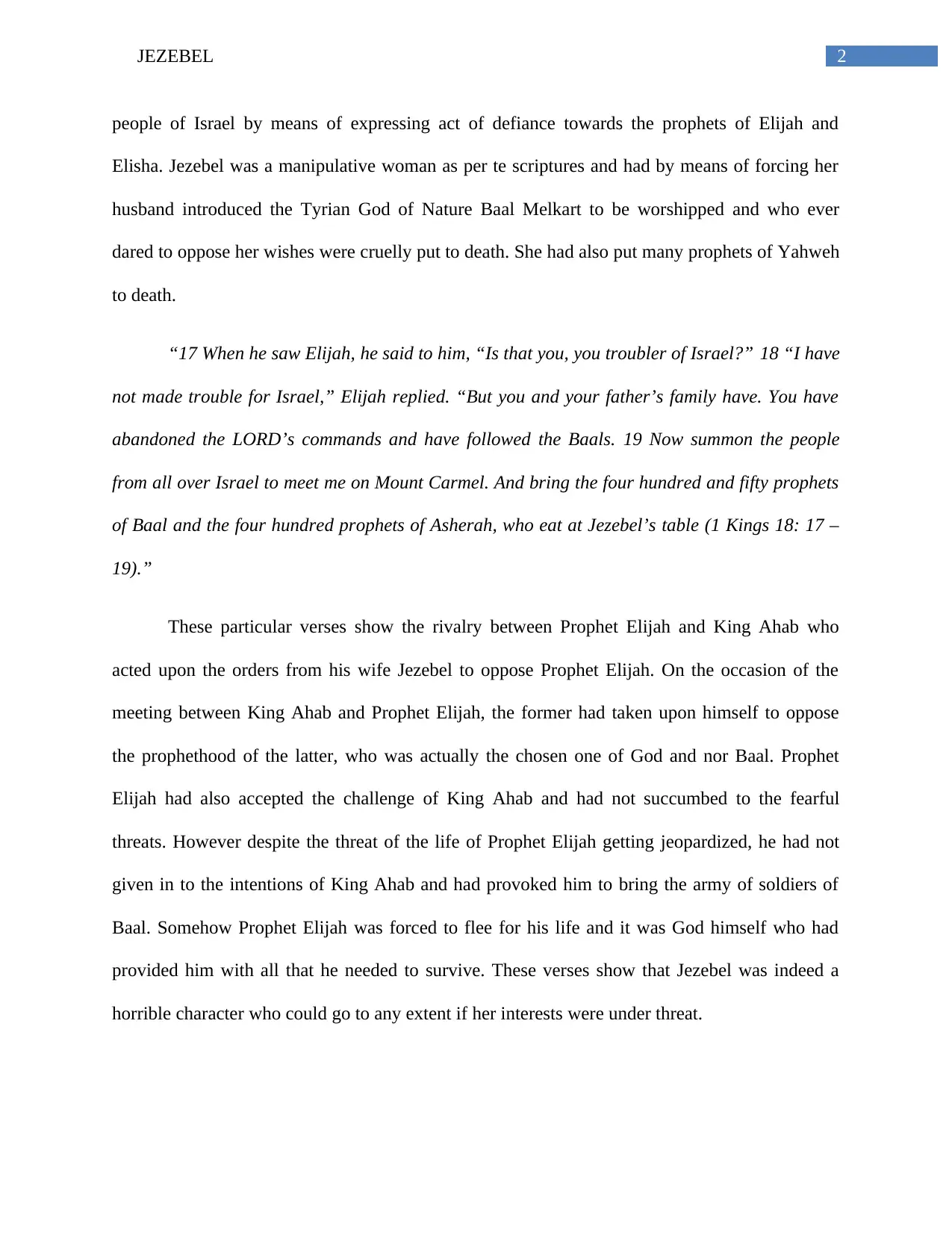
2JEZEBEL
people of Israel by means of expressing act of defiance towards the prophets of Elijah and
Elisha. Jezebel was a manipulative woman as per te scriptures and had by means of forcing her
husband introduced the Tyrian God of Nature Baal Melkart to be worshipped and who ever
dared to oppose her wishes were cruelly put to death. She had also put many prophets of Yahweh
to death.
“17 When he saw Elijah, he said to him, “Is that you, you troubler of Israel?” 18 “I have
not made trouble for Israel,” Elijah replied. “But you and your father’s family have. You have
abandoned the LORD’s commands and have followed the Baals. 19 Now summon the people
from all over Israel to meet me on Mount Carmel. And bring the four hundred and fifty prophets
of Baal and the four hundred prophets of Asherah, who eat at Jezebel’s table (1 Kings 18: 17 –
19).”
These particular verses show the rivalry between Prophet Elijah and King Ahab who
acted upon the orders from his wife Jezebel to oppose Prophet Elijah. On the occasion of the
meeting between King Ahab and Prophet Elijah, the former had taken upon himself to oppose
the prophethood of the latter, who was actually the chosen one of God and nor Baal. Prophet
Elijah had also accepted the challenge of King Ahab and had not succumbed to the fearful
threats. However despite the threat of the life of Prophet Elijah getting jeopardized, he had not
given in to the intentions of King Ahab and had provoked him to bring the army of soldiers of
Baal. Somehow Prophet Elijah was forced to flee for his life and it was God himself who had
provided him with all that he needed to survive. These verses show that Jezebel was indeed a
horrible character who could go to any extent if her interests were under threat.
people of Israel by means of expressing act of defiance towards the prophets of Elijah and
Elisha. Jezebel was a manipulative woman as per te scriptures and had by means of forcing her
husband introduced the Tyrian God of Nature Baal Melkart to be worshipped and who ever
dared to oppose her wishes were cruelly put to death. She had also put many prophets of Yahweh
to death.
“17 When he saw Elijah, he said to him, “Is that you, you troubler of Israel?” 18 “I have
not made trouble for Israel,” Elijah replied. “But you and your father’s family have. You have
abandoned the LORD’s commands and have followed the Baals. 19 Now summon the people
from all over Israel to meet me on Mount Carmel. And bring the four hundred and fifty prophets
of Baal and the four hundred prophets of Asherah, who eat at Jezebel’s table (1 Kings 18: 17 –
19).”
These particular verses show the rivalry between Prophet Elijah and King Ahab who
acted upon the orders from his wife Jezebel to oppose Prophet Elijah. On the occasion of the
meeting between King Ahab and Prophet Elijah, the former had taken upon himself to oppose
the prophethood of the latter, who was actually the chosen one of God and nor Baal. Prophet
Elijah had also accepted the challenge of King Ahab and had not succumbed to the fearful
threats. However despite the threat of the life of Prophet Elijah getting jeopardized, he had not
given in to the intentions of King Ahab and had provoked him to bring the army of soldiers of
Baal. Somehow Prophet Elijah was forced to flee for his life and it was God himself who had
provided him with all that he needed to survive. These verses show that Jezebel was indeed a
horrible character who could go to any extent if her interests were under threat.
⊘ This is a preview!⊘
Do you want full access?
Subscribe today to unlock all pages.

Trusted by 1+ million students worldwide
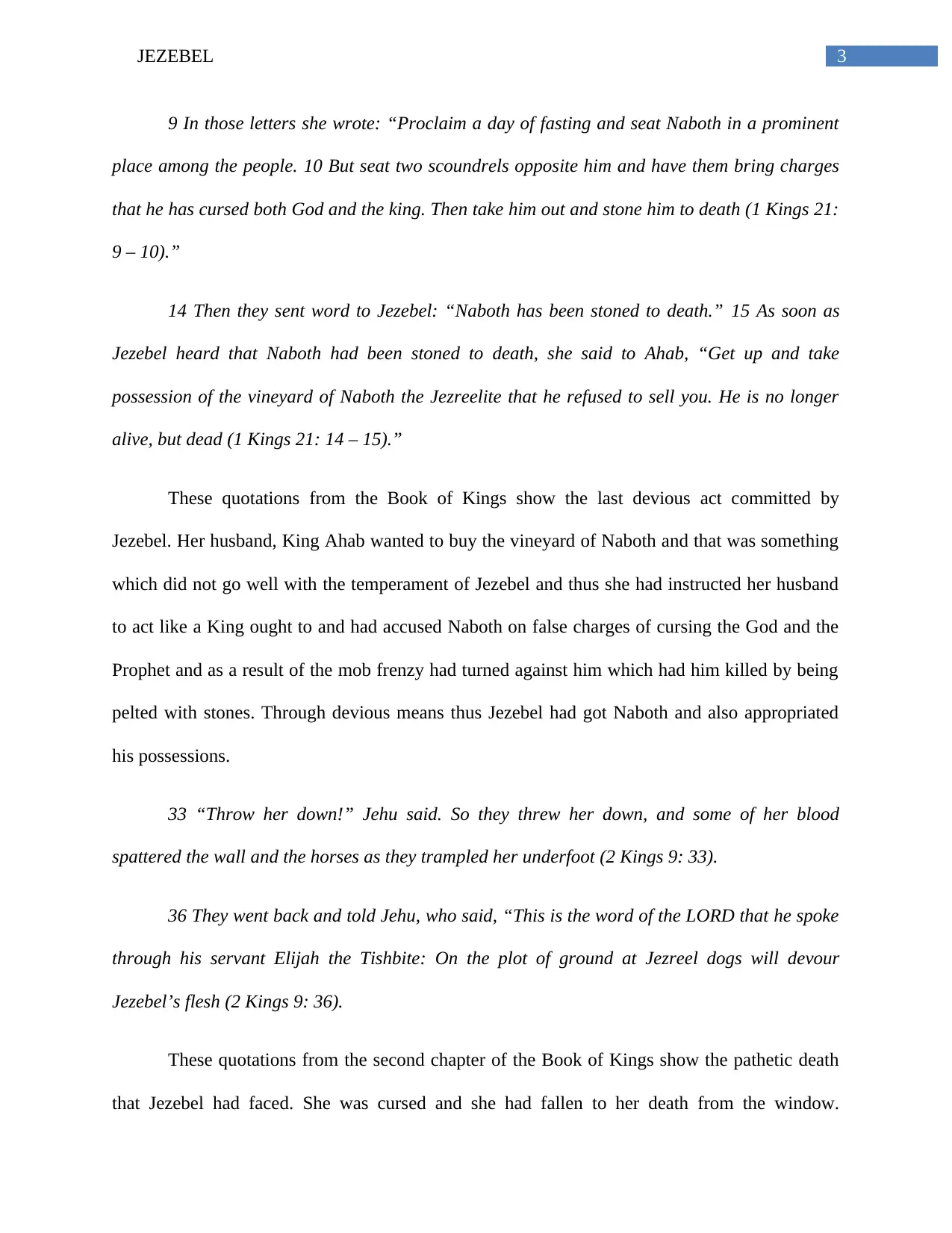
3JEZEBEL
9 In those letters she wrote: “Proclaim a day of fasting and seat Naboth in a prominent
place among the people. 10 But seat two scoundrels opposite him and have them bring charges
that he has cursed both God and the king. Then take him out and stone him to death (1 Kings 21:
9 – 10).”
14 Then they sent word to Jezebel: “Naboth has been stoned to death.” 15 As soon as
Jezebel heard that Naboth had been stoned to death, she said to Ahab, “Get up and take
possession of the vineyard of Naboth the Jezreelite that he refused to sell you. He is no longer
alive, but dead (1 Kings 21: 14 – 15).”
These quotations from the Book of Kings show the last devious act committed by
Jezebel. Her husband, King Ahab wanted to buy the vineyard of Naboth and that was something
which did not go well with the temperament of Jezebel and thus she had instructed her husband
to act like a King ought to and had accused Naboth on false charges of cursing the God and the
Prophet and as a result of the mob frenzy had turned against him which had him killed by being
pelted with stones. Through devious means thus Jezebel had got Naboth and also appropriated
his possessions.
33 “Throw her down!” Jehu said. So they threw her down, and some of her blood
spattered the wall and the horses as they trampled her underfoot (2 Kings 9: 33).
36 They went back and told Jehu, who said, “This is the word of the LORD that he spoke
through his servant Elijah the Tishbite: On the plot of ground at Jezreel dogs will devour
Jezebel’s flesh (2 Kings 9: 36).
These quotations from the second chapter of the Book of Kings show the pathetic death
that Jezebel had faced. She was cursed and she had fallen to her death from the window.
9 In those letters she wrote: “Proclaim a day of fasting and seat Naboth in a prominent
place among the people. 10 But seat two scoundrels opposite him and have them bring charges
that he has cursed both God and the king. Then take him out and stone him to death (1 Kings 21:
9 – 10).”
14 Then they sent word to Jezebel: “Naboth has been stoned to death.” 15 As soon as
Jezebel heard that Naboth had been stoned to death, she said to Ahab, “Get up and take
possession of the vineyard of Naboth the Jezreelite that he refused to sell you. He is no longer
alive, but dead (1 Kings 21: 14 – 15).”
These quotations from the Book of Kings show the last devious act committed by
Jezebel. Her husband, King Ahab wanted to buy the vineyard of Naboth and that was something
which did not go well with the temperament of Jezebel and thus she had instructed her husband
to act like a King ought to and had accused Naboth on false charges of cursing the God and the
Prophet and as a result of the mob frenzy had turned against him which had him killed by being
pelted with stones. Through devious means thus Jezebel had got Naboth and also appropriated
his possessions.
33 “Throw her down!” Jehu said. So they threw her down, and some of her blood
spattered the wall and the horses as they trampled her underfoot (2 Kings 9: 33).
36 They went back and told Jehu, who said, “This is the word of the LORD that he spoke
through his servant Elijah the Tishbite: On the plot of ground at Jezreel dogs will devour
Jezebel’s flesh (2 Kings 9: 36).
These quotations from the second chapter of the Book of Kings show the pathetic death
that Jezebel had faced. She was cursed and she had fallen to her death from the window.
Paraphrase This Document
Need a fresh take? Get an instant paraphrase of this document with our AI Paraphraser
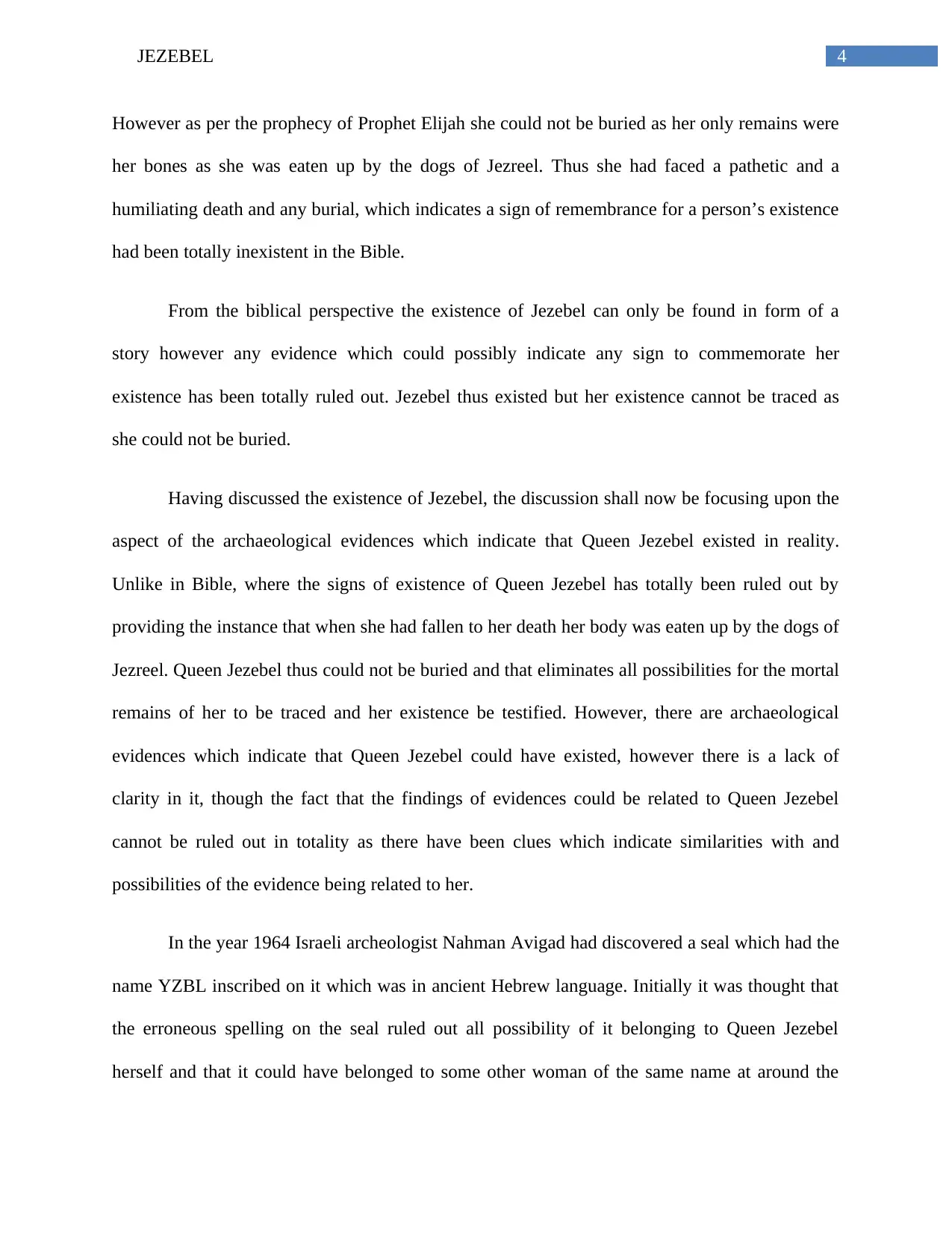
4JEZEBEL
However as per the prophecy of Prophet Elijah she could not be buried as her only remains were
her bones as she was eaten up by the dogs of Jezreel. Thus she had faced a pathetic and a
humiliating death and any burial, which indicates a sign of remembrance for a person’s existence
had been totally inexistent in the Bible.
From the biblical perspective the existence of Jezebel can only be found in form of a
story however any evidence which could possibly indicate any sign to commemorate her
existence has been totally ruled out. Jezebel thus existed but her existence cannot be traced as
she could not be buried.
Having discussed the existence of Jezebel, the discussion shall now be focusing upon the
aspect of the archaeological evidences which indicate that Queen Jezebel existed in reality.
Unlike in Bible, where the signs of existence of Queen Jezebel has totally been ruled out by
providing the instance that when she had fallen to her death her body was eaten up by the dogs of
Jezreel. Queen Jezebel thus could not be buried and that eliminates all possibilities for the mortal
remains of her to be traced and her existence be testified. However, there are archaeological
evidences which indicate that Queen Jezebel could have existed, however there is a lack of
clarity in it, though the fact that the findings of evidences could be related to Queen Jezebel
cannot be ruled out in totality as there have been clues which indicate similarities with and
possibilities of the evidence being related to her.
In the year 1964 Israeli archeologist Nahman Avigad had discovered a seal which had the
name YZBL inscribed on it which was in ancient Hebrew language. Initially it was thought that
the erroneous spelling on the seal ruled out all possibility of it belonging to Queen Jezebel
herself and that it could have belonged to some other woman of the same name at around the
However as per the prophecy of Prophet Elijah she could not be buried as her only remains were
her bones as she was eaten up by the dogs of Jezreel. Thus she had faced a pathetic and a
humiliating death and any burial, which indicates a sign of remembrance for a person’s existence
had been totally inexistent in the Bible.
From the biblical perspective the existence of Jezebel can only be found in form of a
story however any evidence which could possibly indicate any sign to commemorate her
existence has been totally ruled out. Jezebel thus existed but her existence cannot be traced as
she could not be buried.
Having discussed the existence of Jezebel, the discussion shall now be focusing upon the
aspect of the archaeological evidences which indicate that Queen Jezebel existed in reality.
Unlike in Bible, where the signs of existence of Queen Jezebel has totally been ruled out by
providing the instance that when she had fallen to her death her body was eaten up by the dogs of
Jezreel. Queen Jezebel thus could not be buried and that eliminates all possibilities for the mortal
remains of her to be traced and her existence be testified. However, there are archaeological
evidences which indicate that Queen Jezebel could have existed, however there is a lack of
clarity in it, though the fact that the findings of evidences could be related to Queen Jezebel
cannot be ruled out in totality as there have been clues which indicate similarities with and
possibilities of the evidence being related to her.
In the year 1964 Israeli archeologist Nahman Avigad had discovered a seal which had the
name YZBL inscribed on it which was in ancient Hebrew language. Initially it was thought that
the erroneous spelling on the seal ruled out all possibility of it belonging to Queen Jezebel
herself and that it could have belonged to some other woman of the same name at around the
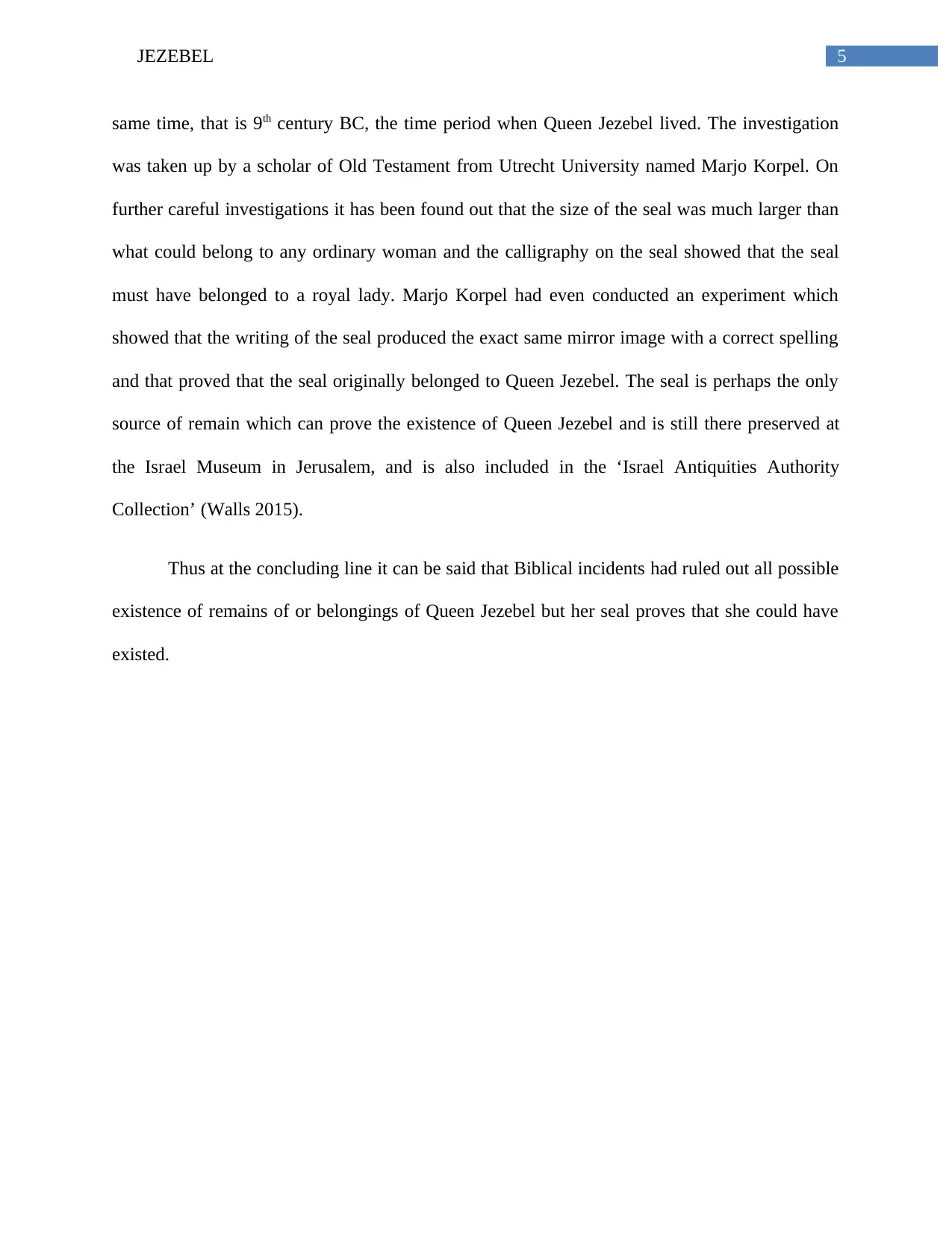
5JEZEBEL
same time, that is 9th century BC, the time period when Queen Jezebel lived. The investigation
was taken up by a scholar of Old Testament from Utrecht University named Marjo Korpel. On
further careful investigations it has been found out that the size of the seal was much larger than
what could belong to any ordinary woman and the calligraphy on the seal showed that the seal
must have belonged to a royal lady. Marjo Korpel had even conducted an experiment which
showed that the writing of the seal produced the exact same mirror image with a correct spelling
and that proved that the seal originally belonged to Queen Jezebel. The seal is perhaps the only
source of remain which can prove the existence of Queen Jezebel and is still there preserved at
the Israel Museum in Jerusalem, and is also included in the ‘Israel Antiquities Authority
Collection’ (Walls 2015).
Thus at the concluding line it can be said that Biblical incidents had ruled out all possible
existence of remains of or belongings of Queen Jezebel but her seal proves that she could have
existed.
same time, that is 9th century BC, the time period when Queen Jezebel lived. The investigation
was taken up by a scholar of Old Testament from Utrecht University named Marjo Korpel. On
further careful investigations it has been found out that the size of the seal was much larger than
what could belong to any ordinary woman and the calligraphy on the seal showed that the seal
must have belonged to a royal lady. Marjo Korpel had even conducted an experiment which
showed that the writing of the seal produced the exact same mirror image with a correct spelling
and that proved that the seal originally belonged to Queen Jezebel. The seal is perhaps the only
source of remain which can prove the existence of Queen Jezebel and is still there preserved at
the Israel Museum in Jerusalem, and is also included in the ‘Israel Antiquities Authority
Collection’ (Walls 2015).
Thus at the concluding line it can be said that Biblical incidents had ruled out all possible
existence of remains of or belongings of Queen Jezebel but her seal proves that she could have
existed.
⊘ This is a preview!⊘
Do you want full access?
Subscribe today to unlock all pages.

Trusted by 1+ million students worldwide

6JEZEBEL
References
Walls, Neal. "The gods of Israel in comparative ancient Near Eastern context." The Wiley
Blackwell Companion to Ancient Israel (2015): 261-277.
References
Walls, Neal. "The gods of Israel in comparative ancient Near Eastern context." The Wiley
Blackwell Companion to Ancient Israel (2015): 261-277.
1 out of 7
Your All-in-One AI-Powered Toolkit for Academic Success.
+13062052269
info@desklib.com
Available 24*7 on WhatsApp / Email
![[object Object]](/_next/static/media/star-bottom.7253800d.svg)
Unlock your academic potential
Copyright © 2020–2025 A2Z Services. All Rights Reserved. Developed and managed by ZUCOL.
